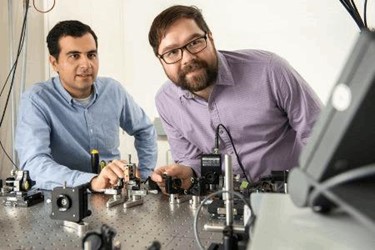Seeing Optical Parametric Oscillators In A New Light
By Jof Enriquez, Follow me on Twitter @jofenriq

Stanford researchers have bucked standard guidelines to retool a formerly finicky device to shoot ultrafast light pulses useful in remote sensing and diagnostic applications.
Optical parametric oscillators (OPO) can produce light in wider wavelengths than conventional lasers. Until now, however, OPOs have been limited to labs because the ultrafast light beams and pulses they generate can easily get out of alignment.
The team at the Stanford University’s Ginzton Lab successfully addressed the delicate nature of these little-known light sources by changing the dynamics of how light is produced in the device.
First, a conventional laser is passed through a modified crystal and converted into a wavelength range that is usually inaccessible to traditional lasers. Second, the light pulses are bounced off a series of mirrors in a feedback loop, which is synchronized to the incoming laser pulses to create a strong output.
The researchers knew, though, that they then had to increase the conversion for their lab experiment to be applied in practical terms.
“We needed higher conversion efficiency to prove it was a source worth studying,” said Alireza Marandi, a staff member in the Ginzton Lab. “So we just said, ‘OK, what are the knobs we have in the lab?’ We turned one that made the mirrors reflect less light, which was against the standard guidelines, and the conversion efficiency doubled.”
Previously, increasing the power caused pulses to lengthen and the conversion efficiency to fall. Counterintuitively, the team discovered they could avoid those problems by making the mirrors less reflective.
“We were thinking about this regime based on the standard design guidelines, but the behavior we would see in the lab was different,” said Marc Jankowski, lead author of the paper and a graduate student in the Ginzton Lab. “We were seeing an improvement in performance, and we couldn’t explain it.”
In addition to decreasing the reflectivity of the mirrors, lengthening the feedback loop helped synchronize the laser pulses. This unforeseen synchronization more than doubled the bandwidth of the output, which means it can emit ultra-short light pulses in a broader span of wavelengths within the range that is difficult to access with conventional lasers.
Ultrafast light pulses produced by OPOs in the Stanford team’s new design can be as short as 18 femtoseconds, fast enough to detect the movement of distinct molecules. This paves the way for diagnostic tests to detect molecules in a person’s breath, or environmental sensors that can analyze a molecule in the air.
The next challenge for the Stanford researchers is to make their device more compact, possibly even small enough to fit in a chip. Their work with optical parametric oscillators proves there is more to be accomplished with existing systems if new approaches are explored.
“You talk with people who have worked with this technology for the past 50 years and they are very skeptical about its real-life applications because they think of these resonators as a very high-finesse arrangement that is hard to align and requires a lot of upkeep,” said Marandi, a co-author of the paper published recently in Physical Review Letters. “But in this regime of operation, these requirements are super-relaxed, and the source is super-reliable and doesn’t need the extensive care required by standard systems.”
